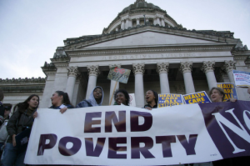Fundamental transformation of the country continues:
Federal budget data confirm that rising enrollment and cost is the real untold story of almost all welfare programs in America today.
Just 18 years ago Republicans and Clinton Democrats joined together to pass landmark legislation to "end welfare as we know it." But today, welfare has been redesigned and expanded, not reformed.
The traditional cash welfare program, once known as AFDC, has shrunk — thanks in part to strict work requirements. But the new-age welfare is a conglomeration of dozens of income-support programs — some aren't even labeled welfare — as generous and costly as ever.
In 2011, the latest year for which we have complete spending data, federal outlays on all means-tested
welfare programs targeted for the poor hit $746 billion, according to an analysis by the Congressional Research Service.
But this doesn't include two of the fastest-growing taxpayer-funded cash subsidies: unemployment insurance and disability, which are not based on one's income level, so are not considered anti-poverty programs. That's another $250 billion a year. All told, federal income transfer programs (not including Social Security and Medicare) have hit $1 trillion.
Adding state spending, the Senate Budget Committee found another $257 billion spent each year. The welfare state is now larger than the GDP of 175 of the 190 wealthiest countries.
Astoundingly, if all this spending were simply sent in the form of a check to every household in America living below the poverty level, we could raise each of these family's incomes not just above the poverty line, but double that level, according to Robert Rector of the Heritage Foundation. Every poor family of four could have a cash income of $44,000 a year — which in most countries would be princely.
Most Americans probably have no idea how expansive the welfare state is. That's because the cost is disguised by more than 80 separate means-tested programs counted by the CRS, including cash benefits, health care, social services, food, child care, training, and housing and utility subsidies. They often have overlapping and uncoordinated missions. This explains the vast duplication of effort, with at least 12 programs offering food and nutrition, 18 offering housing assistance, nine offering vocational training, and so on.
In all, just over 100 million Americans now get some form of welfare-based government benefit. This does not include Medicare or Social Security. Obama's economics team thinks the more the better, because these are programs that "stimulate" the economy.
Oh, and by the way: These numbers do not include the ObamaCare expansion of Medicaid, which could add 20 million to the rolls over time. Obama boasts of 5 million more Americans now being eligible for Medicaid under ObamaCare, as if that's an applause line.
This is unsustainable. And there's little evidence that the truly needy are being helped.
It's a travesty and it's destroying this country.
God help us.
 welfare programs targeted for the poor hit $746 billion, according to an analysis by the Congressional Research Service.
welfare programs targeted for the poor hit $746 billion, according to an analysis by the Congressional Research Service.